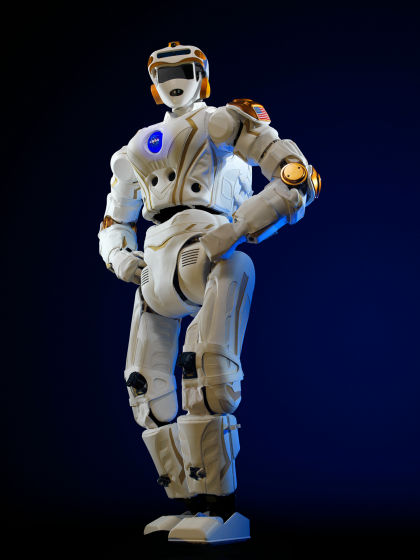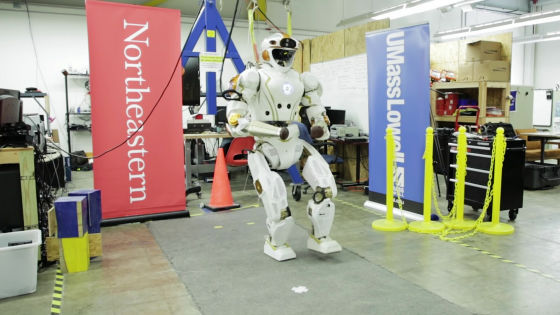A humanoid robot "Valkyrie (Valkyrie)" that goes to Mars before human beings and arranges the living environment

NASA is developing a robot to do work that can not be done by humans in the harsh environment of the universe. Among them, a humanoid robot capable of bipedal walking "R5"(alias:Valkyrie) Will be given an important role to greatly support the Martian resettlement plan by mankind.
Valkyrie | NASA
https://www.nasa.gov/feature/valkyrie
Space Robotics Challenge | NASA
https://www.nasa.gov/directorates/spacetech/centennial_challenges/space_robotics/index.html
You can understand how the space robot "Valkyrie (Valkyrie)" developed by NASA has a sense of balance of human beings with a single shot when looking at the following movie.
Meet R 5: Valkyrie - YouTube
Valkyrie was developed at the Johnson Space Center in NASA in 2013 to participate in DARPA-sponsored robot contest "DRARA Robotics Challenge (DRC)". Even after DRC, improvement was added to Valkyrie, Valkyrie improved hands and redesigned his ankle to further improve durability and version upgraded sensor, NASA's 100th anniversary project "Space Robotics Challenge (SRC)" It was offered to MIT and researchers at North Eastern University as a competition robot.

Mr. Wong Sik of Doctor of North Eastern University participating in SRC received an interview from TechCrunch and explained in the following movie about Valkyrie under adjustment.
Northeastern puts NASA's Valkyrie space robots through its paces - YouTube
In order to live a human on Mars, you need a robot that creates buildings and prepares energy harvesting means and sets the living environment by getting on Mars in front of humans. Valkyrie is expected to play a role in arranging the living environment of Mars.

"The universe is definitely a harsh environment for human beings, so a robot that will help us in the universe will be the necessary presence to lower the risk," Won Sick said.

Since there is no arm at the present time, Valkyrie has 32 movable areas.

The frame is equipped with a multi-sensing camera.

In addition, the body has another camera, and by combining images from different angles, you can recognize the surrounding situation in three dimensions.

A broken arm is attached with a dummy. Originally Valkyrie's wrist with four fingers is said that NASA is under repair.

Biped walking ability is not an essential condition because the robot that aims to work in outer space does not need to support its own weight. However, Valkyrie is supposed to live with human beings on Mars, making it a humanoid robot capable of bipedalism.

In response to the question "Is it easier and superior in terms of technology to move with wheels?", "I think there are various ways of thinking by researchers, but Valkyrie is for human beings It is reasonable to be able to imitate the movement of humans if you think about creating an environment and living in the same environment as humans, "Mr. Wonshick answered.

In addition, although it is Valkyrie who can walk a biped, I support the body from the top with an auxiliary belt so as not to collapse. This is to avoid the risk that an expensive Valkyrie of 2 million dollars (about 220 million yen) per unit falls down and breaks.

Wonshick thinks that NASA leases Valkyrie to Northeastern University and MIT and allows him to research and expand the possibilities of Valkyrie.

Wongshik's team continues to brush up the program because SRC competes for visual system, bipedal walking ability, mobility to move around in small places, and so on.

Mr. Wonshick says, "Personally, I believe that a robot to live at home is needed, I think that robots will be able to expand all possibilities in the home and the universe with robots."

This is an obstacle made to challenge the SRC. Valkyrie is programmed so that you can understand what kind of obstacles and how to clear before you reach where you are now.

Valkyrie can take out not only the movement but also the table and the box from the box, and if these abilities are available, it can adapt either at home or in the universe. Mr. Wonshick asked if he wants to develop a robot for consumers, "I am still in the early stages, but I see at least that first step", he says.

Mr. Wonshick says that Valkyrie feels affinity and humanity. "I think that there are many people who are now strangely thinking about my emotions, but I think that the day will come the same kind of emotions someday." By such emotions, human beings and robots can have a good relationship I think that it is.

For the question "How long will it take Valkyrie to take an active part in space?", I answered that it will be a few years and probably will be Valkyrie different from the present figure / shape.

Aiming for a mission on Mars Valkyrie's Robot Contest with Valkyrie The final match of SRC took place from 13th to 16th June 2017, "Arrangement of Parabolic Antenna for Communication", "Restoration of Solar Power Generator", "Occurred in Buildings Three challenges are given: finding and repairing air leaks. The total prize money of SRC is 1 million dollars (about 110 million yen), the winning team is given 125 thousand dollars (about 14 million yen), and the result announcement is scheduled to be performed on June 30, 2017.

Related Posts:







